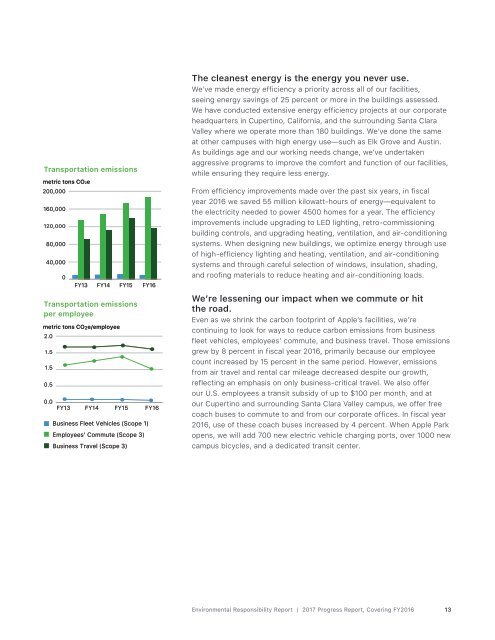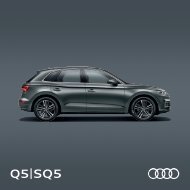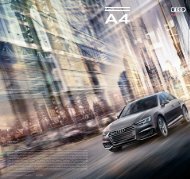Apple Environmental Responsibility Report
Create successful ePaper yourself
Turn your PDF publications into a flip-book with our unique Google optimized e-Paper software.
Transportation emissions<br />
metric tons CO2e<br />
200,000<br />
160,000<br />
120,000<br />
80,000<br />
40,000<br />
0<br />
FY13 FY14 FY15 FY16<br />
Transportation emissions<br />
per employee<br />
metric tons CO2e/employee<br />
2.0<br />
1.5<br />
1.5<br />
0.5<br />
0.0<br />
FY13 FY14 FY15 FY16<br />
Business Fleet Vehicles (Scope 1)<br />
Employees’ Commute (Scope 3)<br />
Business Travel (Scope 3)<br />
The cleanest energy is the energy you never use.<br />
We’ve made energy efficiency a priority across all of our facilities,<br />
seeing energy savings of 25 percent or more in the buildings assessed.<br />
We have conducted extensive energy efficiency projects at our corporate<br />
headquarters in Cupertino, California, and the surrounding Santa Clara<br />
Valley where we operate more than 180 buildings. We’ve done the same<br />
at other campuses with high energy use—such as Elk Grove and Austin.<br />
As buildings age and our working needs change, we’ve undertaken<br />
aggressive programs to improve the comfort and function of our facilities,<br />
while ensuring they require less energy.<br />
From efficiency improvements made over the past six years, in fiscal<br />
year 2016 we saved 55 million kilowatt-hours of energy—equivalent to<br />
the electricity needed to power 4500 homes for a year. The efficiency<br />
improvements include upgrading to LED lighting, retro-commissioning<br />
building controls, and upgrading heating, ventilation, and air-conditioning<br />
systems. When designing new buildings, we optimize energy through use<br />
of high-efficiency lighting and heating, ventilation, and air-conditioning<br />
systems and through careful selection of windows, insulation, shading,<br />
and roofing materials to reduce heating and air-conditioning loads.<br />
We’re lessening our impact when we commute or hit<br />
the road.<br />
Even as we shrink the carbon footprint of <strong>Apple</strong>’s facilities, we’re<br />
continuing to look for ways to reduce carbon emissions from business<br />
fleet vehicles, employees’ commute, and business travel. Those emissions<br />
grew by 8 percent in fiscal year 2016, primarily because our employee<br />
count increased by 15 percent in the same period. However, emissions<br />
from air travel and rental car mileage decreased despite our growth,<br />
reflecting an emphasis on only business-critical travel. We also offer<br />
our U.S. employees a transit subsidy of up to $100 per month, and at<br />
our Cupertino and surrounding Santa Clara Valley campus, we offer free<br />
coach buses to commute to and from our corporate offices. In fiscal year<br />
2016, use of these coach buses increased by 4 percent. When <strong>Apple</strong> Park<br />
opens, we will add 700 new electric vehicle charging ports, over 1000 new<br />
campus bicycles, and a dedicated transit center.<br />
<strong>Environmental</strong> <strong>Responsibility</strong> <strong>Report</strong> | 2017 Progress <strong>Report</strong>, Covering FY2016<br />
13







